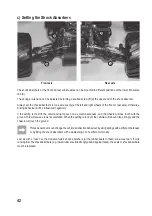
44
b) Setting the Tooth Backlash
The distance between the motor pinion (A) and main
pinion (B) must be as low as possible without the gears
being too tight.
How to achieve this?
Loosen the two motor attachment screws slightly. Then
push the motor with the motor pinion in the direction of
the main pinion with light pressure.
The motor pinion and the main pinion now engage
without clearance. However, this is not perfect for the
service life of the gears!
Put a thin paper strip (no more than 80g paper!)
between the motor pinion and the main pinion. Then
manually turn the main pinion so that the paper strip is
pulled in between the two pinions.
The pressure of the paper pushes back the electric motor by the required measure.
Now tighten the motor’s attachment screws again in this position.
If you then turn back the main cogwheel so that the paper strip can be removed again, both cogwheels should have
the correct distance.
Ideally, the motor pinion should be as close as possible to the main pinion without the teeth touching and
the gears therefore being tight.
If the cogwheels (motor pinion and main cogwheel) are too far apart, the main cogwheel teeth will be
virtually shaved off by the motor pinion after a few seconds – this will void the warranty/guarantee!
If the motor pinion presses against the main cogwheel (teeth are running without play), this will decrease
performance, increase power consumption (the motor already requires lots of power to turn the main gear)
and lead to premature wear.
A
B
















































